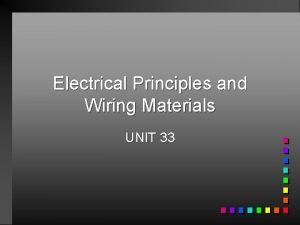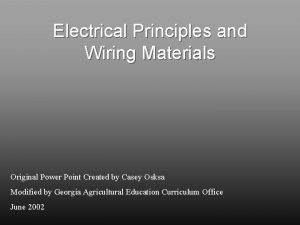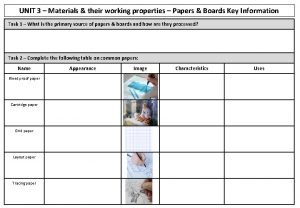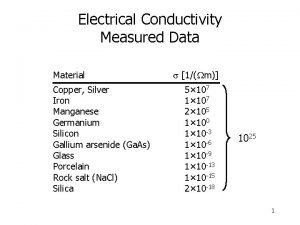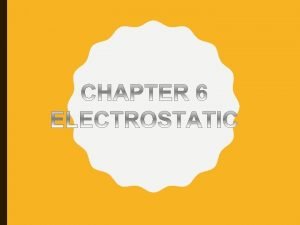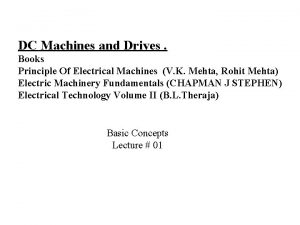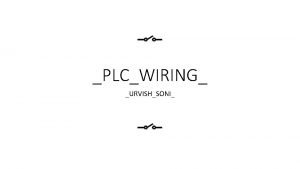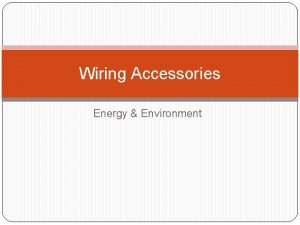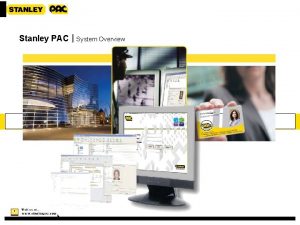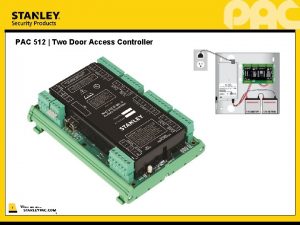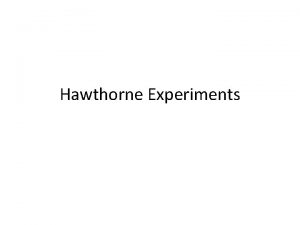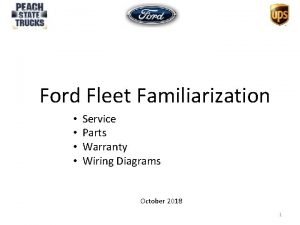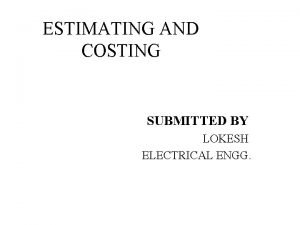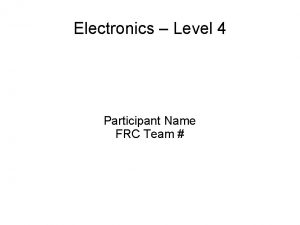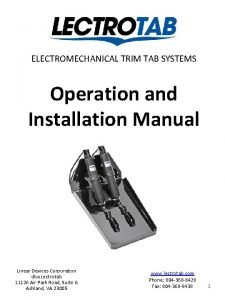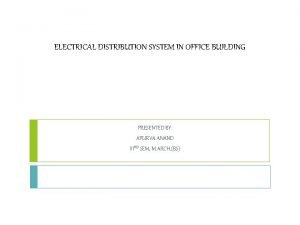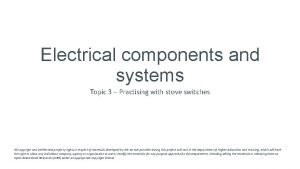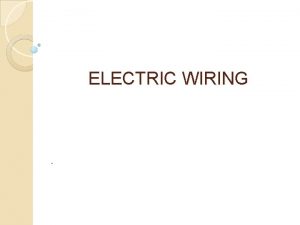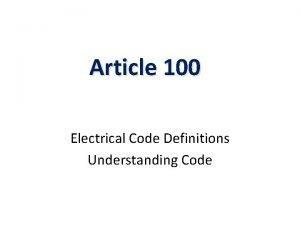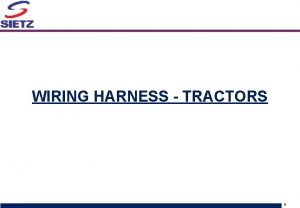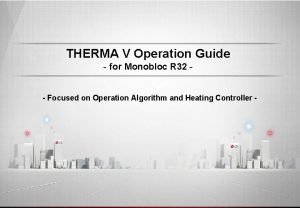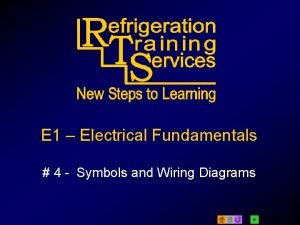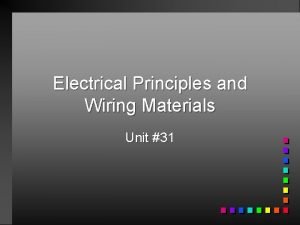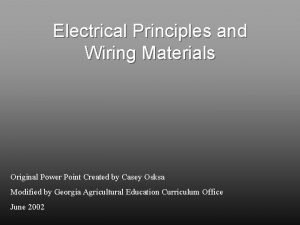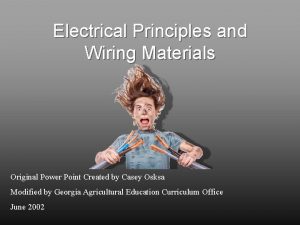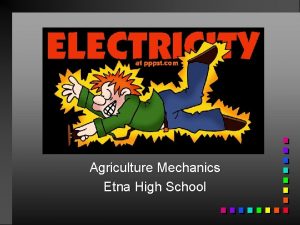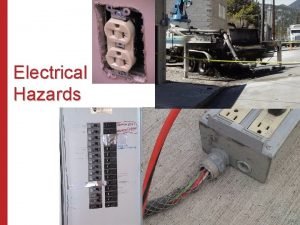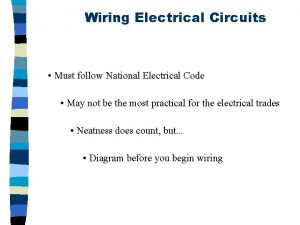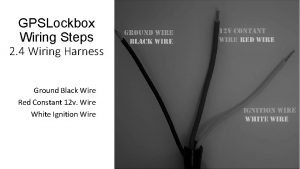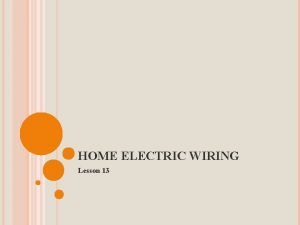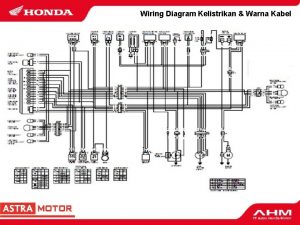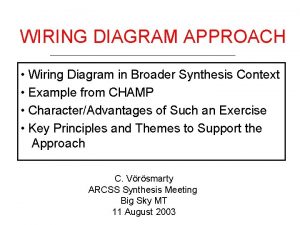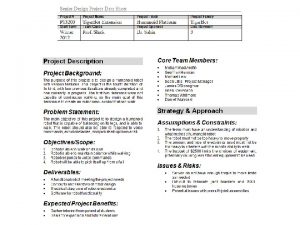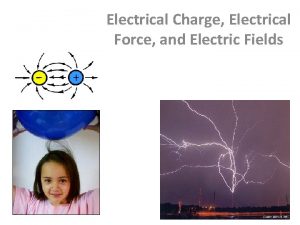Electrical Principles and Wiring Materials Unit 31 Principles






























































- Slides: 62

Electrical Principles and Wiring Materials Unit #31

Principles of Electricity is a form of energy that can produce light, heat, magnetism, chemical changes n Resistance: tendency of a material to prevent electrical flow n Conductor: if electricity flows easily n Insulator: material that provides great resistance n

Amps, Volts, Watts Amperes: measure of the rate of flow of electricity in a conductor n Volts: measure of electrical pressure n Watts: measure of the amount of energy or work that can be done n Ohms: measure of electrical resistance to flow n

Ohm’s Law Ohm = R n Volts = E n Amps = I n Ohm’s Law: E = IR n I=E/R R=E/I

Electrical Safety Shock and Fire n Never disconnect any safety device n Don’t touch electrical items with wet hands or feet n Don’t remove ground plug prong n Use GFI in wet areas n Discontinue use of extension cord that feels warm n Don’t put extension cords under carpet n

Electrical Safety n Install wiring according to NEC n Blown fuse or breaker, determine cause n Don’t replace fuse with larger fuse

Electrical Safety Don’t leave heat producing appliances unattended n Heaters & lamps away from combustibles n Don’t remove back of TV (30, 000 v when off) n Electric motors lubricated, free of grease etc n

Electrical Safety Keep appliances dry n Don’t use damaged switches, outlets, fixtures, extension cords n Follow manufacturer’s instructions for installation and use of electrical equipment n

The path of Electricity

Service Entrance Power from power company n Transformer: drops volts from 25, 000 volts to 240 volts n Service drop: wires etc from transformer to house n Entrance head: weather-proof at house n Meter: $$$ n Service Entrance Panel (SEP): box with fuses or breakers n

Transformer

Service Drop

Service Entrance Panel

Electric Meter Kilowatthours: how electricity is sold n Kilo = 1000 n Watthour = use of 1 watt for one hour n n 100 watt light bulb for 1 hour - 100 watthours n Kilowatthour = 1000 watts for one hour

Electric Meter Box

Branch Circuits usually begin at SEP n branch out into a variety of places n only 1 motor or; n series of outlets or; n series of lights n use correct size wire and fuse or breaker n

Branch Circuits

Types of Cable Nonmetallic sheathed cable: copper or alluminum wire covered with paper, rubber, or vinyl for insulation n Armored cable: flexible metal sheath with individual wires inside. Wires are insulated n Conduit: tubing with individually insulated wires n

Sheathed Cable and Armored Cable

Wire Type and Size copper n No 14 (14 gauge) = 15 amp circuits n No 12 = 20 amps n No 10 = 30 amps n aluminum use one size larger n lower gauge number = larger wire n No 8 and larger use bundles of wires n current travels on outer surface of wire, so a bundle of smaller wires can carry more n

Voltage Drop loss of voltage as it travels along a wire n lights dim, motors overheat n larger wires have less voltage drop for a given amount of current n longer wire = greater problem n must increase wire size as distance increases n

Wire Identification Type of outer covering, individual wire covering, cable construction, number of wires n Wire type stamped on outer surface n

Wire Types Type T - dry locations n Type TW - dry or wet n THHN - dry, high temps n THW and THWN - wet, high temps n XHHW - high moisture & heat resistance n UF - direct burial in soil but not concrete n

Wire Identification Color coded: black, red, & blue = positive or hot wires which carry current to appliances n White = neutral wires carry current from appliance back to source n Green or Bare = ground all metal boxes and appliances n

Wire Identification Wire Size: 12 -2 has two strands of No. 12 wire (black & white) n 12 -2 w/g same, with one green or bare n 12 -3 has three strands of No. 12 (black, red, white) n 12 -3 w/g same, with green or bare n


Electrical Tools & Components Modified By: Jake Muller

Objectives n Identify wiring tools and wiring components.

Wire sizes and Types

American Wire gauge Wire Diameter in inches 18 0. 040303 5 0. 18194 16 0. 0508214 4 0. 20431 14 0. 064084 3 0. 22942 12 0. 08080810 2 0. 25763 10 0. 10189 8 0. 128496 6 0. 16202 1 0. 2893 0 0. 32486 00 0. 3648

Romex Color Codes • 14 -gauge is white • 12 -gauge is yellow • 10 -gauge is

Wire Types 10/ 2 with ground 12/ 3 with ground 14/ 2

Wire types Continued

Electrical Conduit Types

Breaker Box & SID

Recepticles

Light Switch

Single-Pole Switch

Three Way Switch

Light Sockets

Protection Devices

Circuit Protection Devices

GFCI Receptical

GFCI Breaker

Arc Fault Interrupter

Screw Fuses

Knife/Bar Fuses

Common Grounding

Outlet Grounding

Don'ts

Common Tools

Long-Nose Pliers

Diagonal-Cutting Pliers

Crimper

Multipurpose Tool

Wire Strippers

Cable Ripper

Lineman’s pliers

Automatic wire strippers

Multi. Meter

Amp Meter

Review Objectives n Identify wiring tools and wiring components.
 Principles of wires
Principles of wires Unit 33 electrical principles and wiring materials
Unit 33 electrical principles and wiring materials Wiring
Wiring Electrical installation estimating and costing
Electrical installation estimating and costing Materials and tools in making simple electrical gadgets
Materials and tools in making simple electrical gadgets Indoor unit wiring diagram
Indoor unit wiring diagram Cant stop the feeling trolls go noodle
Cant stop the feeling trolls go noodle Why are materials very useful
Why are materials very useful Natural materials and man made materials
Natural materials and man made materials Adapting and adopting materials
Adapting and adopting materials Magnetic materials used in electrical machines
Magnetic materials used in electrical machines Direct materials budget with multiple materials
Direct materials budget with multiple materials Principles and applications of electrical engineering
Principles and applications of electrical engineering Electrical engineering
Electrical engineering Unit 10, unit 10 review tests, unit 10 general test
Unit 10, unit 10 review tests, unit 10 general test Homework 3 modern materials answers
Homework 3 modern materials answers Unit 2 energy, materials, systems and devices answers
Unit 2 energy, materials, systems and devices answers Solid white board characteristics
Solid white board characteristics Resistivity equations
Resistivity equations Electric force units
Electric force units Principles of electrical machines vk mehta
Principles of electrical machines vk mehta Chapter 44 automotive wiring and wire repair
Chapter 44 automotive wiring and wire repair Input and output devices wiring for plc
Input and output devices wiring for plc What material does not conduct electricity
What material does not conduct electricity Unit 1 materials formulating matter
Unit 1 materials formulating matter Unit 2 materials technology
Unit 2 materials technology Honeywell x618
Honeywell x618 Electrical installation accessories
Electrical installation accessories Dts receiver programming
Dts receiver programming Dts gate motor problems
Dts gate motor problems Rs485 wiring standard
Rs485 wiring standard Stanley pac software
Stanley pac software Psa wiring diagrams
Psa wiring diagrams Pixhawk wiring diagram
Pixhawk wiring diagram Phoenix venturi valve
Phoenix venturi valve Pac 512 wiring diagram
Pac 512 wiring diagram Jaw wiring for weight loss pictures
Jaw wiring for weight loss pictures Auma actuator control wiring diagram
Auma actuator control wiring diagram Nergeco door troubleshooting
Nergeco door troubleshooting Transnasal wiring
Transnasal wiring Lectrotab switch wiring diagram
Lectrotab switch wiring diagram Hawthorne experiment
Hawthorne experiment Www ford ecat dealerconnection com login
Www ford ecat dealerconnection com login Trimble field-iq wiring diagram
Trimble field-iq wiring diagram Disadvantages of cleat wiring
Disadvantages of cleat wiring Frc wiring diagram
Frc wiring diagram Bennett trim tab switch wiring diagram
Bennett trim tab switch wiring diagram Electrical distribution system in building
Electrical distribution system in building 3 heat stove switch circuit diagram
3 heat stove switch circuit diagram Introduction to domestic wiring
Introduction to domestic wiring Plc project report
Plc project report Club car iq wiring diagram
Club car iq wiring diagram Crao vs crvo
Crao vs crvo Dts fencing
Dts fencing Accessible wiring
Accessible wiring Daikin krp wiring diagram
Daikin krp wiring diagram Tractor wiring harness manufacturers
Tractor wiring harness manufacturers Vex cortex wiring diagram
Vex cortex wiring diagram Lg therma v ch14
Lg therma v ch14 Danfoss proportional valve wiring diagram
Danfoss proportional valve wiring diagram Papilloedema fundoscopy
Papilloedema fundoscopy Ezgo dcs troubleshooting
Ezgo dcs troubleshooting Thermostat symbol electrical
Thermostat symbol electrical
